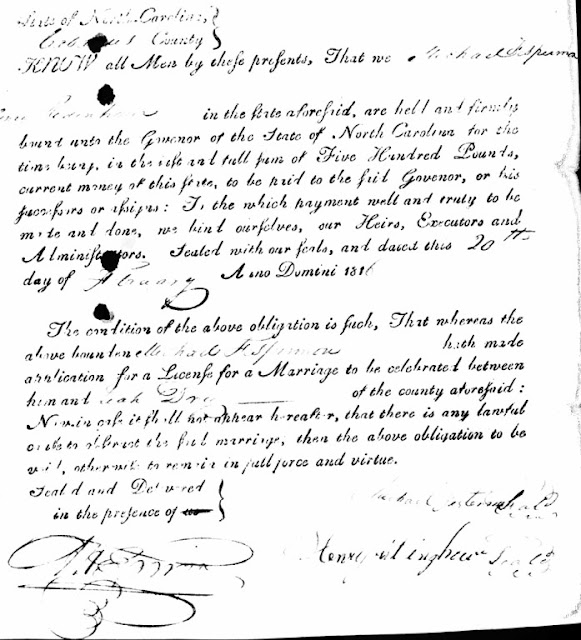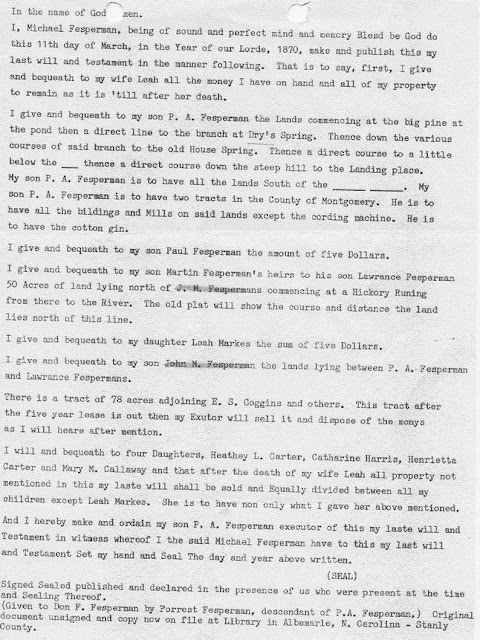 |
| Organ Lutheran Church |
In an attempt to understand what the life of early German settlers must have been like, my two sisters and I visited one of the oldest churches in Rowan County, North Carolina. Zion Lutheran Church, also known as Organ Lutheran Church, founded in 1745, and located on Organ Church Road Salisbury, North Carolina. The founders of this Lutheran church, known as ‘Pennsylvania Dutch’ because of the language they spoke and not the area of Europe they were from, were those Germans who began migrating from Pennsylvania in the mid-1700s, taking the ‘Great Wagon Road’ to the ‘back country’ of North Carolina to begin their lives anew as farmers and laborers. As I walked around the churchyard looking at the names on the gravestones, Misenheimer, Kluttz, Shuping, Shue, and of course, Fesperman, I wondered what my ancestors were like and how they lived. At some point in my wanderings, I realized how beautifully kept the church and yard were.
 | |
| Organ Lutheran Church |
 |
| German village |
Michael Fesperman, born 13 Apr 1792, is my great-great-great-great-grandfather and he and I both are descendants of the Pennsylvania Dutch. Prior to 1840, he resided in Cabarrus County, North Carolina where he met and married Leah Dry on 20 Feb 1816. It is possible that Michael Fesperman is somehow related to the Henry Fesperman found on the 1840 Montgomery County, North Carolina Census listed between 60 and 70 years of age. Leah Dry, born 18 Apr 1794, is the daughter of Andrew and Barbara Teems Dry.
 | |
| ancestry.com |
Michael and Leah had nine children:
Phillip Allen (29 Oct 1816) married Elizabeth A. Carter and remained in Stanly County
Paul Alexander (7 Nov 1818) married Elizabeth Morten and migrated to Webster County, Missouri
Martin A (8 Aug 1820) married Mary Ann Lilly and remained in Stanly County
Leah Caroline (Abt. 1823) married William ‘Buck’ Marks and moved to Montgomery County (my line)
John M (Abt. 1825) I am unclear at this time what happened to John
Heathy (Abt. 1826) married Green Carter and remained in Stanly County
Henrietta L (Abt. 1830) married Tillman Carter and remained in Stanly County
Catharine (Abt. 1832) married Guilford Harris and remained in Stanly County
Mary (Abt. 1838) married a Callaway but I am not sure if she remained in Stanly County
At some point between his marriage in 1816 and 1835, Michael Fesperman moved his family to West Pee Dee River, Montgomery County, North Carolina. The Fesperman family lived within a mile of Dr. Francis Joseph Kron, who had migrated to America from Trier, Prussia and had settled in Montgomery County, North Carolina to make his living as the community doctor. Dr. Kron lived in present day Morrow Mountain and makes mention of Michael Fesperman in his journal dated 1835 saying, “The first inhabited plantation, about a mile from my house, where one Michael Fesperman, a millwright and ingenious mechanician lives; to one accustomed to real farming and careful husbandry, presents nothing but desolation to faithful an image of three-fifths of the plantations in the County. That renders the neglect in this case, more remarkable, is the ability of the proprietor to do better for he is an intelligent and industrious man, and his force of boys enough to show fairer sights. It seems indeed as if the abode was intended as a contrast with the character of its inmate. A man remarkable for the neatness of the machinery he undertakes to finish, yet suffers his fences to be down and rotting in every quarter, his house to be but in-perfect security from rain or cold, his children to be bare-footed and all but naked, his horses and cattle but slovenly sheltered and himself to put up with any way short of perishing from improvidence and neglect. Of this man, a sensible little Dutchman, we intend yet to make a postmaster and a magistrate”
 |
| google image |
 | |
| NC Postal History |
It is obvious from Dr. Kron’s journal that my fourth great grandfather was an intelligent, ingenious, albeit disorganized individual. Michael Fesperman was everything from a millwright to a farmer, postmaster, commissioner of public buildings (see Abstracts of the Minutes of the Court of Pleas and Quarter Sessions of Stanly County 1841-1850 pg. 15) and possibly was even the magistrate of Montgomery or Stanly County. Yet, it would seem, for all of Michael Fesperman’s genius in his work life, his home life suffered. Even with nine children, four of them boys, the Fesperman home and farm seemed to be in neglect with no one putting in the time required to keep things in working order.
Michael Fesperman land grant for 17 ½ acres dated 3 Dec 1838
 | |
| ancestry.com |
Michael Fesperman land grant for 50 acres dated 4 Dec 1840
 | |
| ancestry.com |
The earliest Census that I am sure of is 1840. As noted in a previous Blog, the Census, prior to 1850, only captured the first and last name of the head of the family and everyone else counted by male/female and age range. Researchers now must guess who the numbers are by age range. You can see my guesses below the Census. There is no listing for males between 20 and 30 so I can safely assume that Phillip and Paul have already moved out of their father’s home and are on their own.
 | |
| ancestry.com |
 | |
| My guess work |
Michael Fesperman land grant for 5 acres dated 29 Nov 1842
 |
| ancestry.com |
Michael Fesperman land grant for 90 acres dated 24 Dec 1844
 |
| ancestry.com |
Michael Fesperman land grant for 18 acres dated 10 Jan 1849
 |
| ancestry.com |
In the year 1841, the land west of the Pee Dee River became Stanly County, North Carolina. We must go there to find the Fesperman family in 1850. Michael Fesperman, age 56, listed as a Millwright with a Real Estate value of $200 ($6,028). The only children remaining at home are Henrietta (16), Mary (12), Martin (29) and John (25). We can see that Martin and John are learning their father’s trade and are working in the family business to become Millwrights themselves. It is interesting to note that Mary is attending school, Henrietta can read but neither Martin nor John can read.
 |
| ancestry.com |
A millwright is an artisan or tradesman, who installs, dismantles, repairs, reassembles, and moves machinery in factories, power plants, and construction sites. In the 1800s, millwrights designed, installed, repaired and moved anything mechanized – as a water wheel used that powered the local stone mill where grain was ground into flour or at a sawmill where timber was cut.
 |
| google images |
Michael Fesperman land grant for 2 acres dated 5 Dec 1850
 |
| ancestry.com |
The year 1860 certainly looked great for Michael and Leah Fesperman. All the kids were gone and his Real Estate Value was $3000 ($85,000), Personal Estate $1500 ($43,000). He lists his Occupation as Farmer and Mechanic, still a Millwright, just a change of name for that job.
 |
| ancestry.com |
In the year 1870, we see that Michael has shortened his name to Mike. At 76, Michael looks to remain employed as a Millwright. His Real Estate Value has increased to $12,600 ($227,000) but his Personal Estate is down to $250 ($4,500). Wife, Leah is 75 and we see a namesake from her Dry family is living with or visiting. I have not yet determined who this Leah Dry (15) belongs to but I am sure she is probably the older Leah’s Great Niece, one of her brother’s granddaughters.
 |
| ancestry.com |
It is in March 1870, right before his 77th birthday, that Michael Fesperman becomes concerned about his health and decides to write his will. Below is a transcription of the handwritten will of Michael Fesperman. It seems that my fourth great grandfather has remained bitter towards his daughter, Leah Caroline Fesperman Marks, for more than twenty years. In another Blog I wrote about family tradition saying that Michael Fesperman hired William Buck Marks to educate his children and he and Leah ran off together and married. It is a romantic tale yet I have searched and found no proof that William Marks was an educator. Every Census but one claims he cannot read or write and shows his occupation is a shoemaker. Leah was nearly 27 years old when found on the 1850 Census with William Marks and their first child, Jane R. Why would a 27-year-old woman need to be educated? The 1840 Census, even with guessing, makes clear that she is living at home with her parents. Sometime between the 1840 Census and 1848/49, she meets and marries William Marks and has a child. I do not know how they met or under what circumstances. Perhaps Michael Fesperman and William Marks were business partners of some sort. Perhaps William Marks made shoes for the Fesperman family. Whatever the reasons, it is clear that Michael Fesperman never restored his relationship with his daughter and most likely never knew his grandchildren.
 |
| copy owned by Don Fesperman |
On 22 Mar 1873, Michael Fesperman, died, (it is ironic to note that I would be born exactly 96 years later, across the river, in Troy) his wife, Leah Dry Fesperman, having died 28 Nov 1868, both buried in Badin Baptist Cemetery in Badin, North Carolina.
 |
| Badin Baptist Church, Badin, NC |
On 27 Mar 1873, A.G. Fesperman and P.A. Fesperman were in Probate Court before J.M. Redwine, Probate Judge, and made an application for letters of administration upon the estate of Michael Fesperman. I guess my fourth great grandfather never got around to signing the will that he wrote in 1870.
 |
| ancestry.com |
On the 13 and 16 Apr 1873, A.G. and P.A. Fesperman sold the belongings of Michael Fesperman. Of note, it is quite interesting that Leah Marks (the disowned daughter) showed up at the estate sale and bought items that belonged to her mother and father. The first item is a bed, second item is a cotter pin, and the fourth item is gum camphor.
 |
| ancestry.com |
After paying funeral expenses and debts, the balance from the estate sale divided equally among the children of Michael Fesperman - about $5,900 each.
 |
| ancestry.com |
In what looks to have become a very long and drawn out court battle between the children over the sale of more than 800 acres of land belonging to Michael Fesperman, finally, the case closed in 1901.
Michael Fesperman will located here:
Ancestry.com
No comments:
Post a Comment